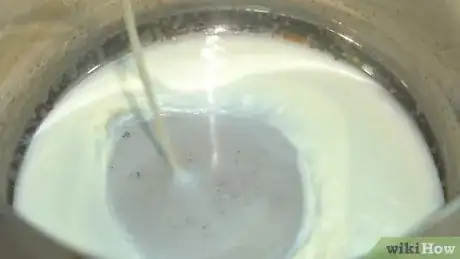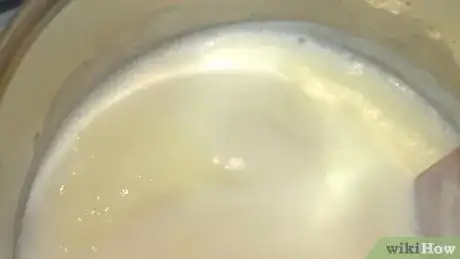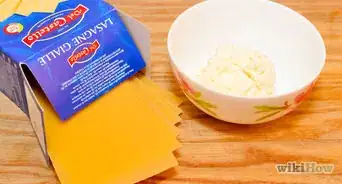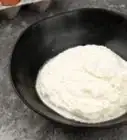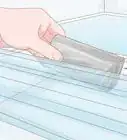This article was co-authored by wikiHow staff writer, Sophia Latorre. Sophia Latorre is a Content Manager on the wikiHow team. Before joining wikiHow, Sophia worked as a technical editor and was published in six International Energy Agency (IEA) Wind Annual Reports. Now, she writes, edits, and reviews articles for the wikiHow Content Team, working to make the content as helpful as possible for readers worldwide. Sophia holds a BA in English from Colorado State University.
There are 17 references cited in this article, which can be found at the bottom of the page.
The wikiHow Culinary Team also followed the article's instructions and verified that they work.
This article has been viewed 147,150 times.
Learn more...
Making cheese may seem like a daunting process, but it's actually something you can do at home. If you're brand new to cheese-making, start with a simple farm cheese. Once you have a bit more experience, try making cheddar cheese. Before you know it, you'll be crafting your own delectable cheese recipes!
Ingredients
- 1 gallon (3.8 L) of milk (not ultra-pasturized)
- 1⁄2 cup (120 mL) of white vinegar
- 2 tsp (10 g) of sea salt (very fine)
- 10 quarts (9.5 L) of whole milk
- ⅛ tsp (a dash) of mesophilic culture
- 12 drops of annatto in 1⁄4 cup (59 mL) of water
- 1⁄2 teaspoon (2.5 mL) of calcium chloride in 1⁄4 cup (59 mL) of water
- 1⁄2 teaspoon (2.5 mL) of liquid rennet in 1⁄4 cup (59 mL) of water
- 1½ tablespoons (25.5 g) of non-iodized (cheese) salt
- Coconut oil (for banding)
Steps
Basic Process
-
1Boil milk or cream. Bring your milk or cream to a boil in a heavy-bottomed pan, stirring frequently. The type of dairy you choose affects both the flavor and texture of the cheese. For a richer cheese, use heavy cream. Alternatively, opt for milk if you want to make a lighter cheese. Just be sure to choose high-quality milk or cream—the fresher, the better![1]
Did You Know? Most cheese recipes caution against using ultra-pasteurized milk or cream because the pasteurization process prevents the milk from forming curds.
-
2Add acid to curdle the dairy. Different recipes call for different acids, including vinegar, lemon juice, buttermilk, citric acid, or rennet. Once your milk or cream is boiling, stir in the acid and watch as the curds and whey begin to separate before your very eyes—it may take 10 minutes or so.[2]
- The curds are solid chunks of milk protein, while the whey is the remaining liquid.
- Using the right amount of acid is really important. If you add too much, the flavor will be off, but if you don't add enough, the milk won't curdle. That's why it's best to follow a recipe until you have some experience with cheese-making.
Advertisement -
3Strain the mixture and add salt and other seasonings. Pour the mixture through a few pieces of cheesecloth into a strainer. The goal is to catch the curds and let the whey drain out, which may take around 15 minutes. Then, use your hands to press excess liquid out of the cheesecloth, sprinkle salt over the curds, and mix it in.[3]
- At this point, you can also add other seasonings, including herbs, if you want.
-
4Press the cheese if desired. After straining and draining the mixture, your cheese will have a texture similar to ricotta. If you prefer a firmer cheese, wrap the cheese in cheesecloth, shape the curds into a disk, then press the disk between 2 plates. Leave it in the fridge for a few hours or a few days, depending on the texture you're aiming for.[4]
Farm Cheese
-
1Bring 1 gallon (3.8 L) of milk to a boil. Use fresh milk that has not been ultrapasteurized for this recipe. Pour it into a large pot and heat it over high heat until it comes to a boil. Stir it frequently to keep it from scorching.[5]
-
2Reduce the heat and add 1⁄2 cup (120 mL) of white vinegar. As soon as the milk starts boiling, turn the heat to low. Slowly pour in the vinegar, give it a stir, and watch the milk separate into whey and curds.[6]
Troubleshooting: If your milk doesn't start to separate, add 1 tablespoon (15 mL) of vinegar at a time until the curds and whey are distinct.
-
3Strain and rinse the mixture, then add 2 tsp (10 g) of salt. Place 2 large pieces of cheesecloth over a colander. Pour the mixture from the pot into the cheesecloth-lined colander to let the whey drain out, then rinse the curds with cool water. Next, sprinkle very fine sea salt over the curds and mix it in.[7]
-
4Remove the excess whey and let the cheese dry for 1-2 hours. Knot the top of the cheesecloth or tie it with string or a rubber band. Squeeze the excess liquid out of the cheesecloth using your hands. Hang up the cheesecloth and allow it to dry.[8]
-
5Chop up your cheese, then store it for up to 7 days. After an hour or 2, place the cheesecloth on a cutting board and untie it. Use a sharp knife to chop up the cheese into smaller pieces—they can be as big or small as you like. Enjoy the cheese immediately or transfer it to a resealable container and put it in the fridge.[9]
Cheddar Cheese
-
1Heat 10 quarts (9.5 L) of whole milk to 88 °F (31 °C). Pour the milk into a double boiler and put it on a burner set to medium heat. Let it come to the target temperature without stirring or otherwise disturbing the milk.[10]
- Use a thermometer to monitor the temperature.
-
2Add ⅛ tsp (a dash) of mesophilic culture and let the milk ripen for 40 minutes. Once the milk reaches 88 °F (31 °C), sprinkle the mesophilic culture evenly over the surface. After 30 seconds or so, gently stir the culture into the milk. Then, put a lid on the double boiler and wait for 40 minutes.[11]
- Mesophilic culture is a starter bacteria used to convert lactose (milk sugar) to lactic acid.
-
3Stir in the annatto, calcium chloride, and liquid rennet. While stirring continuously, but gently, add 12 drops of annatto mixed in 1⁄4 cup (59 mL) of water, 1⁄2 teaspoon (2.5 mL) of calcium chloride mixed in 1⁄4 cup (59 mL) of water, and 1⁄2 teaspoon (2.5 mL) of liquid rennet mixed in 1⁄4 cup (59 mL) of water.[12]
- Completely stir in each ingredient before adding the next. Once all the ingredients are incorporated, gently stir the milk for up to 1 minute.
- Annatto adds color, rennet is the acid in the recipe (which separates the milk into curds and whey), and calcium chloride adds calcium to the cheese.
-
4Cover the mixture and let it curdle for 40 minutes, then cut the curd. Put the lid on the double boiler and let the mixture sit for 40 minutes. Then, dip a clean finger into the mixture. If your finger breaks cleanly through the skin on the top of the mixture, it's ready. If the mixture is still soupy, wait another 10 minutes for it to firm up.[13]
- Next, cut the curd into 1⁄2 inch (1.3 cm) cubes by placing a curd cutter in the pot and rotating it around to cut the curds horizontally. Use a knife to make vertical cuts in both directions.
-
5Heat the mixture to 102 °F (39 °C) over 45 minutes, stirring continuously. Put the lid back on the double boiler and allow the curds to “heal” for 5 minutes. Then, remove the lid, turn up the heat, and stir continuously for 45 minutes.[14]
- Let the heat increase slowly, rather than cranking the burner to high to try and speed up the process.
-
6Let the curds settle for 40 minutes, then strain the mixture. Once the mixture reaches the target temperature, put the lid on the double boiler. Wait 40 minutes for the curds to settle to the bottom of the pot. Then, pour the mixture into a colander lined with cheesecloth.[15]
- If done correctly, the curds will come out in 1 big lump.
-
7Rest the curds for 45 minutes, flipping them every 10-15 minutes. Let the curds drain, then return them to the pot. Cut the lump of curds in half, then flip over each half, put the lid on, and let them rest for 10 minutes. Flip them over and let them rest for another 10 minutes. Flip them again and let them rest for 10 minutes, then flip them a final time and let them rest for 15 minutes.[16]
- Aim to keep the temperature at 102 °F (39 °C).
Did You Know? This is known as the “cheddaring” process and is important for removing excess whey from the curd to make the cheese firmer. It gets its name from the village of Cheddar in Somerset, England, where cheddar cheese was first made.[17]
-
8Drain the curd, cut it into 1⁄2 inch (1.3 cm) cubes, then mill the curds. Drain the whey through a fresh cheesecloth into a colander. Transfer the curd to a cutting board and slice it into cubes. Then, use your hands to break each curd in half (called milling) and put them back in the pot.[18]
-
9Mix in 1½ tbsp (25.5 g) of cheese salt and transfer the curd to a cheese basket. Sprinkle the salt evenly over the curds, then use your hands to thoroughly mix it in. Next, line a cheese basket with a fresh piece of cheesecloth. Transfer the curds to the basket, cover them with the overhanging cheesecloth, and press the follower (lid) on top.[19]
- Be sure to use "cheese salt," which is non-iodized.
-
10Press the cheese at 24 pounds (11 kg) for 1 hour. Set the cheese press to the correct weight and let it sit for an hour. If you don't have a cheese press, just put the right amount of weight on top of the cheese to help form it. Allow the cheese to drain freely so any excess whey can be removed.[20]
- Pressing the cheese forms it into a dense wheel.
-
11Flip the cheese and press it at 50 pounds (23 kg) for 12 hours. Unscrew the press, remove the former, and take the cheesecloth and cheese out of the press. Carefully flip the cheese over, wrap it back up in the cheesecloth, and put it back in the press. Let it sit for 12 hours at 50 pounds (23 kg) to firm up.[21]
- Check the pressure and retighten the spring after 6 hours, if necessary.
-
12Air-dry the cheese for 2-3 days, turning it twice per day. Remove the cheese from the press and unwrap it. Let it dry in a clean area where it won't be disturbed. The cheese will turn yellow as time passes.[22]
-
13Cloth-band the cheese. Cut 2 squares and 1 rectangle out of loose-weave cheesecloth. Coat the cheese with coconut oil. Then, wrap the rectangular piece around the circumference of the cheese, adding more oil to make the cloth stick to the cheese as necessary. Trim away any excess cheesecloth, then put the 2 square pieces on the top and bottom of the cheese. Dip your hands in the coconut oil and use them to secure and smooth out the cheesecloth.[23]
- You can use lard in place of coconut oil.
- Using a cloth band instead of wax makes the cheese more flavorful.
-
14Age the cheese for at least 3 months at 50 °F (10 °C). Be sure to rotate the cheese each week. If you want a sharper cheddar, let the cheese age longer.[24]
- As cheese ages, the lactose continues to break down into lactic acid, which results in a more sour flavor.
Community Q&A
-
QuestionCan I make cheddar without the rennet and mesophilic culture starter?
 Community AnswerYou can make cheese without them, but it won't be cheddar cheese. The mesophilic culture gives cheddar its distinctive flavor. The rennet causes the solid curds to separate from the liquid whey. Curdling the milk is a necessary step in all cheese making.
Community AnswerYou can make cheese without them, but it won't be cheddar cheese. The mesophilic culture gives cheddar its distinctive flavor. The rennet causes the solid curds to separate from the liquid whey. Curdling the milk is a necessary step in all cheese making.
Things You'll Need
Farm Cheese
- Large pot
- Spoon
- Colander
- Cheesecloth
- Measuing cups and spoons
Cheddar Cheese
- Double boiler
- Thermometer
- Cheesecloth
- Measuing cups and spoons
- Curd cutter
- Knife
- Cutting board
- Cheese press
- Cheese board
- Cheese mat
References
- ↑ https://www.epicurious.com/recipes-menus/how-to-make-super-easy-fresh-cheese-article
- ↑ https://www.epicurious.com/recipes-menus/how-to-make-super-easy-fresh-cheese-article
- ↑ https://www.epicurious.com/recipes-menus/how-to-make-super-easy-fresh-cheese-article
- ↑ https://www.epicurious.com/recipes-menus/how-to-make-super-easy-fresh-cheese-article
- ↑ https://nourishedkitchen.com/farm-cheese-recipe/
- ↑ https://nourishedkitchen.com/farm-cheese-recipe/
- ↑ https://nourishedkitchen.com/farm-cheese-recipe/
- ↑ https://nourishedkitchen.com/farm-cheese-recipe/
- ↑ https://nourishedkitchen.com/farm-cheese-recipe/
- ↑ https://youtu.be/xEnifYNnDCA?t=87
- ↑ https://youtu.be/xEnifYNnDCA?t=103
- ↑ https://youtu.be/xEnifYNnDCA?t=129
- ↑ https://youtu.be/xEnifYNnDCA?t=208
- ↑ https://youtu.be/xEnifYNnDCA?t=265
- ↑ https://youtu.be/xEnifYNnDCA?t=296
- ↑ https://youtu.be/xEnifYNnDCA?t=338
- ↑ https://youtu.be/xEnifYNnDCA?t=12
- ↑ https://youtu.be/xEnifYNnDCA?t=435
- ↑ https://youtu.be/xEnifYNnDCA?t=586
- ↑ https://youtu.be/xEnifYNnDCA?t=646
- ↑ https://youtu.be/xEnifYNnDCA?t=687
- ↑ https://youtu.be/xEnifYNnDCA?t=727
- ↑ https://youtu.be/xEnifYNnDCA?t=785
- ↑ https://youtu.be/xEnifYNnDCA?t=853
About This Article
To make cheese, first line a colander with two layers of cheesecloth. Then, pour 1 gallon (3.75 L) of lightly pasteurized milk into a large pot over medium heat, stirring frequently to keep it from scorching. When the milk comes to a boil, reduce the heat to low and stir in 1/2 cup (120ml) of white vinegar. Once the milk separates into curds and whey, pour it into the colander and rinse it with cold water. Sprinkle the curds with 2 teaspoons of fine sea salt. Tie up the cheesecloth and hang it for 1-2 hours before coarsely chopping the cheese. Serve and enjoy! For other types of cheese to make on your own, like cheddar or gouda cheese, read on!
